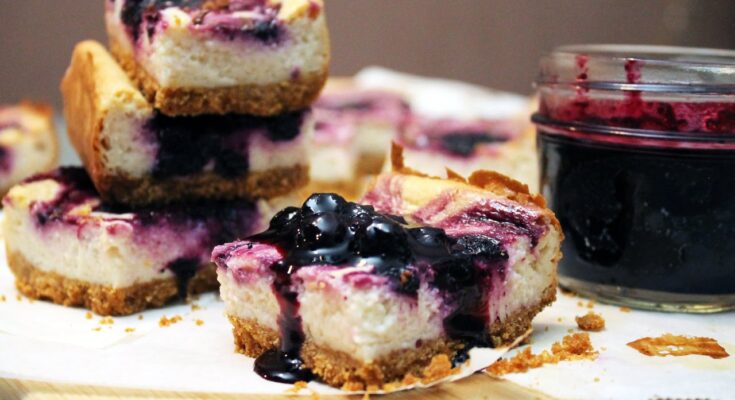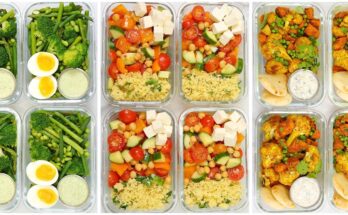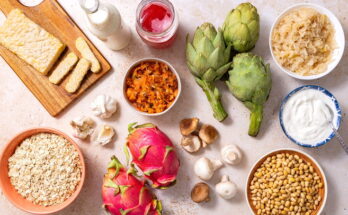Vegan Cheesecake Recipe: Vegan cheesecake is a dairy-free, egg-free alternative to traditional cheesecake, made entirely from plant-based ingredients. Instead of cream cheese and eggs, this delicious dessert typically relies on rich, creamy bases like soaked cashews, coconut cream, silken tofu, or vegan cream cheese to replicate that luxurious, dense texture we all know and love. The result? A luscious, silky-smooth treat that’s kind to animals, easier on your stomach, and just as indulgent as its non-vegan counterpart.
What makes vegan cheesecake even more exciting is its versatility. You can go for a no-bake version that sets in the fridge or opt for a baked version for that authentic, oven-kissed flavor. Plus, it’s easy to infuse it with all your favorite flavors—berries, chocolate, peanut butter, lemon, or even pumpkin spice for the fall.
Vegan cheesecake isn’t just for vegans—lactose-intolerant dessert lovers and those with egg allergies also find this dessert a total game-changer. And don’t worry, you don’t have to sacrifice taste or texture to enjoy this cruelty-free version. If anything, you might even love it more!
Why Go Vegan with Cheesecake?
Choosing a vegan cheesecake isn’t just about following a trend. It’s a conscious decision that aligns with a more compassionate, health-forward, and eco-friendly lifestyle. Here’s why:
- Cruelty-Free: No animals are harmed in the making of your dessert. That means no dairy farms or egg production.
- Lactose-Free: Perfect for those who are lactose intolerant or sensitive to dairy products.
- Cholesterol-Free: Plant-based cheesecakes don’t contain cholesterol, which is only found in animal products.
- Sustainable: The environmental impact of plant-based food production is significantly lower than that of dairy and eggs.
- Healthier Ingredients: Many vegan recipes rely on whole-food ingredients like nuts, oats, dates, and coconut, which add fiber and healthy fats.
Going vegan with your cheesecake allows you to indulge guilt-free, knowing you’re doing your part for your health, the animals, and the planet.
Taste and Texture Expectations
So what does a vegan cheesecake actually taste like? If you’re new to the world of plant-based baking, you might be skeptical—but trust us, it’s downright dreamy. Here’s what to expect:
- Creamy Texture: Thanks to ingredients like soaked cashews or coconut milk, the filling is smooth and creamy—no one will guess it’s dairy-free.
- Rich Flavor: Vegan cheesecakes often feature natural sweeteners like maple syrup or agave, combined with vanilla, lemon juice, or fruit purees for flavor depth.
- Perfectly Sweet: They’re sweet, but not overly sugary. You can adjust sweetness to your taste, unlike many overly processed store-bought desserts.
- Nutty, But Not Overpowering: If made with cashews, you’ll get a mild nutty flavor that blends beautifully with the other ingredients.
- Firm or Soft—Your Choice: Depending on whether you bake it or keep it no-bake, you can choose the final texture—from dense and firm to mousse-like and soft.
You’re not compromising with vegan cheesecake—you’re leveling up!
Ingredients You’ll Need
For the Crust
Let’s start with the base of every good cheesecake—the crust. This can make or break your dessert, so we’ll keep it simple but full of flavor.
Ingredients:
- 1 ½ cups vegan graham cracker crumbs or crushed digestive biscuits
- ¼ cup melted coconut oil or vegan butter
- 2 tablespoons maple syrup or agave nectar
- ½ teaspoon cinnamon (optional, for warmth)
Alternatives:
- Use crushed dates and almonds for a raw crust.
- For gluten-free: Use gluten-free cookies or oats.
The crust should be sticky enough to hold together when pressed but not too oily or wet. You’ll press this into your pan and either pre-bake it (for baked cheesecake) or freeze it to set (for no-bake).
For the Filling
Now onto the star of the show—the creamy, dreamy filling. This is where the magic happens.
Base Ingredients:
- 1 ½ cups raw cashews (soaked in water for 4-6 hours or overnight)
- ½ cup coconut cream or full-fat coconut milk
- ⅓ cup maple syrup (or agave nectar)
- ¼ cup lemon juice (adds that tangy cheesecake flavor)
- 1 tablespoon lemon zest (for brightness)
- 2 teaspoons vanilla extract
- Pinch of salt
Optional Add-ins:
- 2 tablespoons melted coconut oil (for firmness)
- 1 tablespoon cornstarch or arrowroot (for baked version)
- ¼ cup plant-based yogurt (for a lighter texture)
The key is to blend everything until completely smooth—no grittiness allowed! A high-speed blender or food processor is a must here.
Optional Toppings and Flavor Add-ins
The beauty of vegan cheesecake lies in its versatility. Here are some ways to jazz it up:
Toppings:
- Fresh berries (blueberries, raspberries, strawberries)
- Fruit compote or coulis
- Vegan chocolate ganache
- Crushed nuts or granola
- Coconut whipped cream
Flavor Ideas:
- Chocolate: Add cocoa powder or melted vegan chocolate to the filling.
- Peanut Butter: Swirl in peanut butter for a nutty twist.
- Pumpkin Spice: Add pumpkin puree and spices for a fall dessert.
- Matcha: Mix in a spoonful of matcha powder for an earthy vibe.
Go as classic or creative as you want—your cheesecake, your rules.
Recommended Brands for Key Ingredients
If you’re unsure which brands to trust for the best vegan cheesecake, here are some tried-and-true favorites:
- Vegan Cream Cheese: Tofutti, Kite Hill, Violife, Miyoko’s
- Plant-Based Yogurt: So Delicious, Forager, Silk
- Maple Syrup: Trader Joe’s Organic, Kirkland Organic
- Coconut Cream: Thai Kitchen, Native Forest
- Vegan Butter: Earth Balance, Miyoko’s Creamery
- Graham Crackers: Nabisco Original (check label), Annie’s Organic
Always check the labels to ensure your ingredients are 100% vegan and meet your dietary preferences.
Essential Tools and Equipment
Kitchen Tools You’ll Need
To make the perfect vegan cheesecake, you’ll need more than just ingredients. Having the right kitchen tools on hand makes the process smoother and ensures a professional result.
Must-Have Tools:
- High-Speed Blender or Food Processor: This is essential for achieving a smooth, creamy filling. A standard blender might leave gritty bits behind, especially if you’re using cashews.
- Springform Pan (8 or 9-inch): This type of pan makes it easy to remove your cheesecake without ruining its shape.
- Mixing Bowls: For mixing the crust and prepping ingredients.
- Measuring Cups and Spoons: Precision matters in baking!
- Rubber Spatula: Helps you scrape every bit of filling out of the blender and smooth the top of your cheesecake.
- Parchment Paper: Optional, but helpful for lining the bottom of your pan to prevent sticking.
- Baking Sheet: If you’re baking your cheesecake, place your pan on a sheet to catch any spills.
- Refrigerator/Freezer Space: For setting the cheesecake, especially if you’re making a no-bake version.
Having these tools ready before you begin can save time and stress. And if you’re a frequent baker, investing in quality tools can seriously level up your dessert game.
Prep Tips Before You Start
Before diving into the step-by-step process, here are some essential prep tips to help you nail your first vegan cheesecake:
- Soak Your Cashews in Advance: This is a must. Soak raw cashews in room-temperature water for at least 4–6 hours or overnight. In a pinch? Boil them for 10 minutes to soften quickly.
- Bring Ingredients to Room Temperature: Especially for the filling. Cold coconut milk or cream can seize up in the blender and affect the texture.
- Line Your Pan: If you’re worried about sticking, line the bottom of your springform pan with parchment paper.
- Test Your Blender or Food Processor: Make sure your equipment is working well. Vegan cheesecake filling needs to be blended until silky smooth—no shortcuts here.
- Taste Test the Filling: Before pouring it into the crust, taste the filling. Too tangy? Add a bit more sweetener. Not enough depth? A touch more vanilla or lemon zest can help.
- Set Aside Enough Time: Vegan cheesecakes require chill time—often 4+ hours in the fridge or overnight for best results.
These tips might seem simple, but they make a big difference. Prep well, and your cheesecake journey will be a lot more fun (and delicious).
Step-by-Step Guide to Making Vegan Cheesecake
Step 1 – Making the Crust
Crush vegan graham crackers or biscuits into fine crumbs and mix with melted coconut oil and a touch of maple syrup. Press firmly into the base of a springform pan and refrigerate for 15–20 minutes to firm up.
Step 2 – Preparing the Filling
Blend soaked cashews, coconut cream, lemon juice, maple syrup, vanilla extract, and a pinch of salt until perfectly smooth. Add a bit of melted coconut oil to help the filling set.
Step 3 – Assembling the Cheesecake
Pour the creamy filling evenly over the chilled crust and smooth the top with a spatula.
Step 4 – Baking or Chilling (No-Bake Option)
For baked cheesecake, bake at 325°F (160°C) for 35–40 minutes, then cool completely. For no-bake, chill for 4–6 hours until set.
Step 5 – Cooling, Topping, and Serving
Top with fresh berries, fruit compote, or chocolate drizzle, slice, and serve—rich, creamy, and beautifully plant-based!
Tips for the Perfect Vegan Cheesecake
Common Mistakes to Avoid
Even experienced bakers can hit a few snags when making vegan cheesecake. Here are the top missteps to watch out for:
- Using Low-Quality Cashews: Raw, unsalted cashews make the creamiest filling. Roasted ones alter flavor and texture.
- Skipping the Soaking: Soaked cashews are essential for a smooth blend. Short on time? Soften by boiling them for 10 minutes.
- Over- or Underbaking: Overbaking leads to cracks. Underbaking results in a gooey mess. Look for a firm edge and jiggly center.
- Poor Blending: If your blender isn’t powerful, your filling could end up gritty. Always aim for silky smooth.
- Not Chilling Long Enough: Patience pays off. A fully set cheesecake holds its shape and tastes better.
Learning from others’ mistakes saves time and heartbreak—trust us, we’ve been there.
Ingredient Swaps and Variations
Want to make it nut-free, soy-free, or gluten-free? No problem.
Nut-Free Version:
- Replace cashews with silken tofu or sunflower seed butter.
- Use oat or cookie crust instead of almond or nut-based ones.
Soy-Free Version:
- Avoid tofu-based cream cheese or yogurt—opt for coconut-based or almond-based options.
Gluten-Free Version:
- Use gluten-free graham crackers, oats, or even shredded coconut for the crust.
Flavor Variations:
- Berry Swirl Cheesecake: Add blended berries to half the filling and swirl.
- Chocolate Cheesecake: Mix in cocoa powder or melted vegan chocolate.
- Pumpkin Cheesecake: Stir in canned pumpkin and spices for a fall twist.
This cheesecake recipe is like a blank canvas. Get creative and make it your own.
Storage and Shelf Life
Proper storage means you can enjoy your cheesecake for days—if it lasts that long!
Fridge:
- Store in an airtight container or cover with plastic wrap.
- Keeps fresh for up to 5–6 days.
Freezer:
- Freeze whole or in slices.
- Wrap tightly in plastic wrap and foil to prevent freezer burn.
- Keeps for up to 2 months.
- Thaw overnight in the fridge before serving.
Pro Tip: Freeze individual slices for easy grab-and-go dessert anytime!
Nutritional Information
Calories and Macros per Slice
Let’s break down the nutritional profile of an average slice of vegan cheesecake (based on an 8-slice cheesecake using cashews, coconut milk, and maple syrup).
Estimated Per Slice:
| Nutrient | Amount |
|---|---|
| Calories | 320–400 kcal |
| Carbs | 28–35g |
| Protein | 5–7g |
| Fat | 22–28g |
| Saturated Fat | 10–15g |
| Fiber | 2–4g |
| Sugar | 15–20g |
These numbers vary based on your ingredients. For example, swapping coconut cream for almond milk lowers the fat content, while adding chocolate increases calories.
While vegan cheesecake isn’t exactly “low-cal,” it’s often more nutrient-dense than traditional cheesecake, with healthier fats, no cholesterol, and fewer processed additives.
Health Benefits of a Vegan Version
Vegan cheesecake isn’t just a dessert—it’s a smarter indulgence. Here’s why it might be the better choice for your health:
1. Dairy-Free Goodness: No lactose, no bloating. Many people have undiagnosed dairy sensitivities. This cheesecake avoids all that discomfort.
2. Heart-Healthier Fats: Made with nuts and coconut instead of butter and cream cheese, it’s rich in monounsaturated fats that support heart health.
3. No Cholesterol: Only animal products contain cholesterol. A vegan version means zero cholesterol, which is good news for your arteries.
4. Full of Nutrients: Cashews are rich in magnesium, copper, and plant protein. Coconut offers lauric acid, a healthy fat with antimicrobial benefits.
5. Fiber Boost: Using whole foods like dates, nuts, and oats adds fiber—a rare find in desserts!
While it’s still a treat, a well-made vegan cheesecake gives you a dose of goodness with every bite.
FAQs about Vegan Cheesecake Recipe
1. Can I freeze vegan cheesecake?
Absolutely! Vegan cheesecake freezes beautifully. Wrap individual slices in plastic wrap, then foil, and store them in an airtight container. They’ll last up to 2 months. Thaw in the fridge overnight before serving for best texture.
2. Is vegan cheesecake healthier than regular cheesecake?
In many ways, yes. It’s typically lower in saturated fat and cholesterol and made with whole-food ingredients like nuts, fruits, and natural sweeteners. However, it’s still calorie-dense—so enjoy it in moderation.
3. Can I use silken tofu instead of cashews?
Yes, silken tofu is a great alternative if you want a lower-fat, nut-free option. It results in a slightly lighter, softer texture. Make sure to press the tofu to remove excess moisture before blending.
4. What’s the best nut-free alternative?
Silken tofu or sunflower seed butter can replace cashews in the filling. For the crust, try oats, seeds, or nut-free cookies. Always check labels to ensure they’re allergen-friendly.
5. Can I make it gluten-free too?
Definitely. Just swap out regular graham crackers for gluten-free ones or use oats and dates. Many vegan recipes are easily adaptable to be gluten-free with simple substitutions.
Conclusion
So there you have it—a complete, step-by-step guide to making the ultimate vegan cheesecake. Whether you’re a longtime vegan or just exploring dairy-free desserts, this recipe proves you can enjoy indulgent treats without compromise.
From soaking your cashews to blending the smoothest filling and selecting your favorite toppings, each step is a chance to get creative. Choose between baked or no-bake versions, tweak the flavor profile, or keep it classic—it’s your cheesecake, your way.
Vegan cheesecake isn’t just a substitute; it’s a delicious dessert in its own right. One slice is enough to convince even the biggest skeptics that going plant-based can be satisfying, rich, and totally crave-worthy.
So roll up your sleeves, prep your ingredients, and dive into a recipe that’s as kind as it is tasty. Happy baking (or chilling)!



